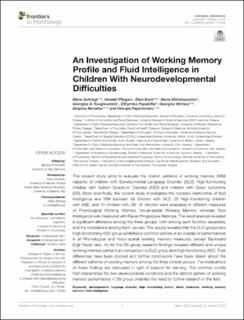| dc.contributor.author | Sofologi, Maria | |
| dc.contributor.author | Pliogou, Vasiliki | |
| dc.contributor.author | Bonti, Eleni | |
| dc.contributor.author | Efstratopoulou, Maria | |
| dc.contributor.author | Kougioumtzis, Georgios A. | |
| dc.contributor.author | Papatzikis, Efthymios | |
| dc.contributor.author | Ntritsos, Georgios | |
| dc.contributor.author | Moraitou, Despina | |
| dc.contributor.author | Papantoniou, Georgia | |
| dc.coverage.spatial | Greece | en_US |
| dc.date.accessioned | 2022-07-08T12:47:15Z | |
| dc.date.available | 2022-07-08T12:47:15Z | |
| dc.date.created | 2022-05-10T08:26:24Z | |
| dc.date.issued | 2022-03-18 | |
| dc.identifier.issn | 1664-1078 | |
| dc.identifier.uri | https://hdl.handle.net/11250/3003880 | |
| dc.description.abstract | The present study aims to evaluate the distinct patterns of working memory (WM) capacity of children with Developmental Language Disorder (DLD), High-functioning children with Autism Spectrum Disorder (ASD) and children with Down syndrome (DS). More specifically, the current study investigates the complex relationship of fluid intelligence and WM between 39 children with DLD, 20 High-functioning children with ASD, and 15 children with DS. All children were evaluated in different measures of Phonological Working Memory, Visual-spatial Working Memory whereas Fluid Intelligence was measured with Raven Progressive Matrices. The result analysis revealed a significant difference among the three groups, both among each function separately and the correlations among them, as well. The results revealed that the DLD groups and High-functioning ASD group exhibited a common picture or an overlap of performances in all Phonological and Visuo-spatial working memory measures, except Backward Digit Recall task. As for the DS group research findings revealed different and unique working memory patterns in comparison to DLD group and High-functioning ASD. Their differences have been studied and further conclusions have been drawn about the different patterns of working memory among the three clinical groups. The implications of these findings are discussed in light of support for learning. The common profile that characterize the two developmental conditions and the distinct pattern of working memory performance in DS group underlies the need for further research in the field. | en_US |
| dc.language.iso | eng | en_US |
| dc.publisher | Frontiers Media | en_US |
| dc.relation.ispartofseries | Frontiers in Psychology;March 2022 | Volume 12 | Article 773732 | |
| dc.rights | Navngivelse 4.0 Internasjonal | * |
| dc.rights.uri | http://creativecommons.org/licenses/by/4.0/deed.no | * |
| dc.subject | Developmental language disorders | en_US |
| dc.subject | High functioning autism | en_US |
| dc.subject | Down's syndrome | en_US |
| dc.subject | Working memory functions | en_US |
| dc.subject | Fluid intelligence | en_US |
| dc.title | An Investigation of Working Memory Profile and Fluid Intelligence in Children With Neurodevelopmental Difficulties | en_US |
| dc.type | Peer reviewed | en_US |
| dc.type | Journal article | en_US |
| dc.description.version | publishedVersion | en_US |
| dc.rights.holder | © 2022 Sofologi, Pliogou, Bonti, Efstratopoulou, Kougioumtzis, Papatzikis, Ntritsos, Moraitou and Papantoniou. | en_US |
| dc.source.articlenumber | 773732 | en_US |
| cristin.ispublished | true | |
| cristin.fulltext | original | |
| cristin.qualitycode | 1 | |
| dc.identifier.doi | https://doi.org/10.3389/fpsyg.2021.773732 | |
| dc.identifier.cristin | 2022894 | |
| dc.source.journal | Frontiers in Psychology | en_US |
| dc.source.volume | 12 | en_US |
| dc.source.issue | 12 | en_US |
| dc.source.pagenumber | 1-14 | en_US |

